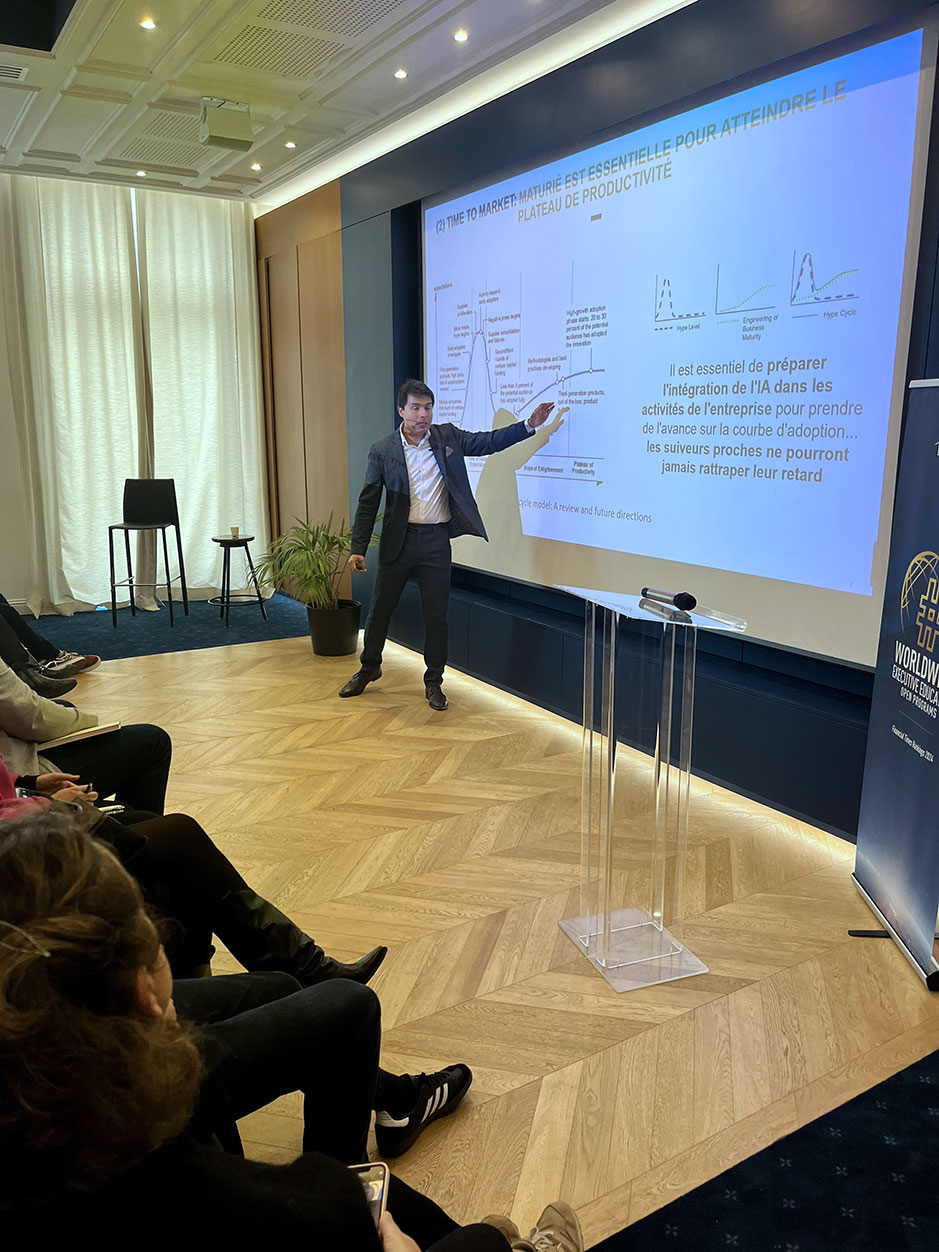Artificial Intelligence: An Opportunity Businesses Can No Longer Afford to Ignore
Recent events make it clear: artificial intelligence is here to stay. In October 2024, the Nobel Prize in Physics was awarded to John Hopfield and Geoffrey Hinton for their pioneering work on artificial neural networks, the foundation of modern AI. 'We’re in the second year of this revolution,' says Ghislain Mazars, co-director of HEC Paris's 'AI Ready for Business' program. This transformation is shaking up not only science but also the economy and organizations worldwide.

AI’s potential is vast, yet remains largely untapped by businesses. To stay competitive, companies must not only understand the foundations of this technology but also learn to embed it within their strategies.
At the recent 'Executive Education Day' hosted by HEC Paris, experts Ghislain Mazars et David Restrepo led a masterclass tackling this very challenge. They demonstrated how AI is deeply transforming organizations and why leaders must urgently develop the skills needed to navigate its complexities.
AI: Just a Trend or a True Revolution?
Understanding this technology and leveraging it for competitiveness is essential.
A Technological Shift Too Big to Ignore
Artificial intelligence is no longer confined to experimental projects in Silicon Valley labs. It has become a core technology across all sectors, from finance and healthcare to industry and retail.

For Ghislain Mazars, co-director of the 'AI ready for business' program, 'we’re going to be immersed in AI for the next 20 to 30 years.' According to him, this transformation is far from a passing trend; it’s a technological upheaval on par with the rise of the internet in the early '90s. 'Today, we’re at a pivotal moment comparable to 1991, when the web was created, or 1993, with the launch of the first internet browsers,' he explains. 'Back then, few used these tools, yet today they are essential.' As AI continues to gain momentum, companies must build genuine expertise in its mechanisms.
Understanding this technology goes beyond practical applications; it’s also about grasping its foundations and capabilities to better anticipate its long-term impacts on organizations. 'This is not a luxury but an imperative to remain relevant in this new phase,' warns Ghislain Mazars. In other words, failing to engage with AI now could ultimately mean a major loss of competitiveness for businesses.
From Passive Users to Change Agents
Until now, technological advancements in business have often left employees in a passive role. While IT systems are ubiquitous, they have mostly been imposed by management with limited room for innovation. Excel, now indispensable, is a prime example: employees learned to use it for small-scale automation, but without truly engaging in the technology’s evolution.
AI, however, is changing this dynamic. It’s no longer just about meeting predefined needs; AI offers transformative capabilities far beyond what was imaginable just a few years ago. As Ghislain Mazars notes, 'AI is Excel on an exponential scale.'
To fully leverage this revolution, companies and their employees must take a more active role. 'We’ve been passive users of IT systems for too long,' Mazars reminds us. Now, the challenge is not just to understand how to use AI but to adapt it to individual and organizational needs.
Human Memory vs Artificial Memory: Which One Does It Better?
Artificial intelligence (AI) systems and human memory operate in fundamentally different ways. While AI is impressive in its processing capabilities, it is not without its limitations.
Memory Capabilities: Humans vs Machines
Human memory is a complex phenomenon that can be broken down into three main types: long-term memory, episodic memory, and short-term memory. Each plays a crucial role in how we retain and process information.
● Long-term memory is the repository for the memories we accumulate over time. 'This memory is constantly evolving', explains Ghislain Mazars. Every time we recall a memory, it is, in a way, rewritten—shaped by our emotions or the context of the recollection.
● Episodic memory allows us to remember specific events we’ve experienced, often selectively and partially. It is essential for our day-to-day continuity, but its precision and retention capacity are limited.
● Short-term memory, also known as working memory, is the most fleeting. It allows us to hold a small amount of information in our minds for a brief period. 'On average, human short-term memory can retain only five to seven items at a time,' notes Ghislain Mazars. Surprisingly, in this respect, humans fall behind some species, like chimpanzees, which can outperform us in storing immediate information.
In contrast to these human limitations, artificial intelligence (AI) exhibits very different memory capabilities. AI memory is primarily based on neural networks that store information as weights in connections, after being trained on large datasets.
'A model of AI essentially consists of two files: a code file and a file containing the neural connection weights', Ghislain Mazars explains.
Unlike human memory, AI memory doesn’t evolve over time unless the model is retrained with new data—a lengthy and resource-intensive process. While humans rewrite memories with each recollection, AI knowledge is fixed after training. This means an AI cannot incorporate new information unless re-trained. However, AI's strength lies in its ability to process vast amounts of information simultaneously. 'While our short-term memory is limited to five or six items, AI can store up to a million objects in its immediate memory', Mazars points out. This quantitative superiority allows AI to outperform human capabilities in certain tasks, especially when dealing with massive volumes of data in record time.
That said, AI lacks the cognitive flexibility of humans. It doesn’t regenerate memories, doesn’t organically evolve over time, and has no episodic memory—each interaction starts from scratch unless provided with a conversation history. AI excels at raw data analysis but remains far behind human cognitive agility, particularly when it comes to selective memory or contextualizing past experiences.
The Importance of Context: How AI Bridges Its Gaps
As we've seen, despite its impressive capabilities, artificial intelligence faces a significant limitation: the lack of true episodic memory. This inability to recall past conversations or tasks often results in disjointed interactions with machines, highlighting the need for technical solutions to fill this gap. Enter the concept of the "context window."
The context window allows AI to temporarily store a limited amount of information from recent interactions. This enables it to simulate continuity in conversations by remembering previous elements, making exchanges with AI feel more coherent.
According to Ghislain Mazars, “Every time you interact with an AI, for the AI, it’s as if it’s the very first interaction—unless it’s provided with the conversation history.”
This means that each question and answer in an exchange with AI is based solely on the information within that context window, not on any real memory.
While this method works for simple conversations, it quickly shows its limitations when interactions become more complex or lengthy. For instance, an AI model can "forget" relevant information if the context window is exceeded or poorly managed. This limitation is one of the main causes of the notorious AI "hallucinations"—moments when the algorithm generates incorrect or fabricated responses. 'The AI simply regurgitates the information available in its immediate memory, but if that information is incomplete or inaccurate, it will produce incoherent answers', explains Ghislain Mazars.
To address these shortcomings, engineers are developing solutions like extending the context window. Initially, this window could only hold a few thousand pieces of information. Today, some advanced models, such as the latest large language models (LLMs), can handle up to a million. 'This significantly increases the AI's ability to maintain coherence over long interactions', notes Ghislain Mazars. By injecting additional data or external contextual information, the accuracy of responses can also be improved, thus reducing the risk of hallucinations.
Another solution is the use of retrieval-augmented generation (RAG), where the AI taps into external databases in real time to supplement its answers with reliable information. 'In RAG mode, AI only uses the information available in the database you provide, which prevents it from generating responses based purely on statistical probabilities', Mazars explains. This retrieval mechanism helps guide AI toward more accurate, fact-based answers, rather than relying solely on the model's neural memory.
AI in Business: Key Steps for a Successful Transition
Integrating AI into businesses is a complex process, often poorly managed, that brings both significant opportunities and substantial risks. How can companies make the most of AI?
Fast but Risky Adoption: What Companies Need to Know
AI adoption in businesses doesn't always follow a clear, well-defined strategy. In reality, it often happens quietly and individually, outside of any formal institutional framework. This creates a major challenge for companies: while AI can boost employee productivity, it also introduces significant risks, particularly information asymmetry and moral hazard.

The problem lies in the fact that AI use often goes unreported. In other words, employees are using AI tools like ChatGPT without informing their supervisors or colleagues.
'Most people don’t want to tell their direct manager that they’ve used ChatGPT, but they want their subordinates to know', explains David Restrepo, co-director of the "AI Ready for Business" program.
This discreet adoption creates an information asymmetry within teams: some employees benefit from AI’s advantages, while others do not, leading to an uneven distribution of work and skewed performance evaluations.
The other major risk is moral hazard. When employees use AI without informing their company, they may make decisions that lead to errors or violations of organizational protocols, especially regarding data protection. For example, uncontrolled use of ChatGPT to process sensitive or confidential information could expose the company to legal risks, even if the AI does not store the data. 'There’s a risk of moral hazard because the individual reaps the immediate benefits of AI, while the company must manage the risks', adds David Restrepo.
Companies must address this phenomenon and formalize AI adoption to harness its advantages while minimizing potential issues. This involves implementing transparent policies on AI tool usage, training teams on the responsible use of these technologies, and creating an institutional framework to govern such practices. While AI has the potential to significantly boost productivity, it will only do so effectively if integrated thoughtfully and in a coordinated manner within the organization.
Leaders must also anticipate the impact of AI on talent and skills. AI tends to reduce performance gaps among employees: less skilled workers see significant improvements in their results thanks to AI, while more competent employees experience only modest gains. This "equalization" of performance raises questions about the long-term value of human expertise. To prevent AI from diluting expertise, companies need to ensure that humans remain at the heart of strategic decision-making, combining the efficiency of machines with the creativity and vision unique to individuals.
Integrating AI into Organizational Processes
Proactively adopting AI at an institutional level is now essential for maximizing its benefits and staying ahead of the competition. 'Companies that fail to integrate AI into their processes risk becoming obsolete compared to those that fully embrace it', warns Ghislain Mazars.
One of the main challenges is preparing the necessary technical infrastructure. AI is not a simple software to install; it requires strong, well-structured, and regularly updated databases. Data quality is crucial for ensuring AI models function correctly and avoiding misinterpretations or algorithmic biases. "If you don't structure your data, you’ll get nowhere," emphasizes David Restrepo. To achieve this, companies need to rethink their information systems and invest in architectures capable of supporting AI integration.
The adoption of AI also demands that teams adapt. Employees must not only understand how to use AI, but also how to seamlessly integrate it into their daily tasks. Training on AI tools is essential to ensure that workers go beyond being mere users; they should learn to leverage these technologies to enhance their productivity and decision-making processes. Additionally, a shift in mindset is crucial: teams need to view AI not as a threat, but as a tool for innovation and increased competitiveness.
For this transition to succeed, the involvement of decision-makers is key. Leadership teams must understand that AI cannot be deployed overnight—it requires preparation, support, and a long-term strategic vision. A common mistake is underestimating the time needed for AI to mature within an organization.
'If you wait for AI to be perfectly refined before adopting it, you’ll already be behind', explains David Restrepo.
The key is to start now, to experiment, and to iterate gradually so the company can build its skills and expertise around AI.
Proactive AI integration must also include a focus on ethics and associated risks. Managing personal data, ensuring information confidentiality, and maintaining transparency in the use of algorithms are essential to sustaining the trust of clients, partners, and employees. 'The regulatory framework is evolving quickly', Restrepo notes, particularly with legislation like the European Union’s AI Act, which imposes training and monitoring obligations on companies using AI.
Becoming a Leader in AI Transformation
One thing is clear: executives and managers must acquire the skills needed to understand and master AI technology. The challenge goes beyond the technical aspects—it’s about grasping the strategic impact of AI, assessing its risks, and leveraging it to sustainably and competitively transform organizations. In a world where AI will increasingly shape how we work and make decisions, leaders' ability to navigate this new environment is becoming crucial.
Being an active player in AI transformation isn’t just about delegating the technological integration to the IT department. Business leaders themselves must be trained in the fundamentals of this revolution to understand how to apply it to their own sectors. 'We need to understand not only how AI works but, more importantly, how it can transform the way we manage our businesses and interact with our teams', explains David Restrepo.
To meet this need, HEC Paris offers the executive program “AI Ready for Business”, designed to guide executives and managers through this transformation.
This comprehensive educational program provides participants with the tools to understand AI fundamentals, use AI tools practically, and, more importantly, identify concrete opportunities for their businesses.
The program is structured around three phases:
- An online module to acquire foundational AI knowledge,
- An immersive day at the HEC campus with interactive sessions,
- A final half-day focused on practical exercises and skill deepening.
One of the program's key strengths is its pragmatic approach. Rather than training AI experts, it aims to equip executives with the ability to "tame" AI technology and apply it effectively within their industry. This training will help participants better understand the economic and organizational implications of AI, anticipate future developments, and make informed decisions regarding digital transformation.
Don’t let this technological revolution leave you behind. Join the “AI Ready for Business” program and become a key player in the AI transformation.